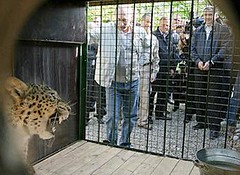 伊朗與俄羅斯將交換兩種大型貓科動物,來自伊朗的2隻波斯豹,與來自俄羅斯的2隻西伯利亞虎。這次交換屬於一項具有雄心的計畫,要讓大型貓科動物在各自國家的數量得以回復,但部分專家認為這是沒有意義的公關活動。
伊朗與俄羅斯將交換兩種大型貓科動物,來自伊朗的2隻波斯豹,與來自俄羅斯的2隻西伯利亞虎。這次交換屬於一項具有雄心的計畫,要讓大型貓科動物在各自國家的數量得以回復,但部分專家認為這是沒有意義的公關活動。
波斯豹已在俄羅斯境內滅絕,但在伊朗仍存有一定數量。
而裏海虎這種野獸被稱作馬贊德蘭(Mazandaran)虎或赫卡尼亞(Hyrcanian)虎,當伊朗一位陸軍上尉霍納華(Ahmad Honarvar)射殺最後一隻裏海虎後,自1950年代晚期以來,伊朗已不再有目擊紀錄。霍納華與虎屍合照的模糊黑白照片,在伊朗徒留惡名。
這場交換的安排決定的十分快速。在2009年12月28日,以自然資源與生態部副部長多斯科伊(Sergei Donskoy)為首的俄羅斯代表團提出交換要求。協商迅速獲得決議,隔年2月21日便簽署備忘錄。交換日期選定於4月24日。
就在兩隻母波斯豹抵達俄羅斯的幾天後,俄羅斯總理普亭5月3日前往索契(Sochi)國家公園探望牠們,這次訪視受到伊朗媒體的大幅報導。一位媒體專家表示,這次的媒體宣傳行動可能有助於舒緩伊朗人因政府外交政策而缺乏國際自尊的心理,此舉意味著伊朗在國外還有幾個朋友,。
俄羅斯對波斯豹的興趣,乃是其計畫在2014年於該國索契舉辦的冬季奧運上,以這種動物作為國家象徵。俄羅斯也在2009年9月接收了土耳其贈送的2隻母波斯豹。
來自伊朗的波斯豹將被飼養於西高加索地區的索契國家公園。兩隻俄羅斯的老虎則將居住在伊朗一處野生動物保護區,位於裏海東南方的米亞克勒(Miankaleh)半島。
俄羅斯專家將會以5年時間管理米亞克勒的老虎復育計畫,與此同時,伊朗專家也將監督波斯豹重新引進高加索地區的計畫。
這四隻動物均為人工繁殖,而重新引進諸如此類的野獸到野外的這個議題,一直以來都具有爭議。由世界自然保護聯盟(IUCN)貓科動物特別小組的兩位共同主持人烏爾斯‧布萊特莫瑟(Urs Breitenmoser) 與克莉絲汀‧布萊特莫瑟-伍斯坦(Christine Breitenmoser- Würsten) 指出,類似的野放僅有30%是成功的。
來自俄羅斯的西伯利亞虎與已滅絕的裏海虎在基因上相似,但並不完全相同。伊朗國立大學(Shahid Beheshti University)生態學教授巴赫拉姆‧吉阿比(Bahram Kiabi)說:「基因相似並不表示西伯利亞虎就是馬贊德蘭虎。這兩種動物只是有親緣關係。」
環境專家與作者巴赫拉姆‧索它尼(Kambiz Bahram Soltani)則認為,引入外來物種到新的棲地是錯誤的,可造成不可逆轉與未知的破壞。
在伊朗荷莫茲海峽格什姆島(Qeshm) 致力於復育玳瑁的生態學家暨野生動物攝影師法漢達瑞索里(Bijan Farhangdarehshouri),同樣也反對重新將大型貓科動物引入伊朗。
他說:「這些老虎不可能被釋放,或說是移居到野外,因為他們曾來沒有在野外生存過。把老虎帶來這裡是政治舉動,我很遺憾見到甚至連環境部都已泛政治化。」
伊朗副總統暨環境部長穆罕默德迪查(Mohammadizadeh)則在接收老虎的典禮上捍衛其計畫,他表示:「這項決定如同本機關其他所有執行的工作,已經加強投入科學研究。」
另一個部門負責回復老虎數量的官員齊伊(Hooshang Ziaie),則相信這項計畫的成功。他說:「重要的問題在於,不僅是要復育老虎,還要回復米亞克勒的棲息環境。老虎來到這裡,會是保護棲地的好理由。」
當被問到西伯利亞虎能否忍受米亞克勒遠比原自然棲地更溫暖的天氣時,米亞克勒野生動物保護區首長阿布塔勒比(Ali Abutalebi)回答:「我們已決定要為這批老虎建造泳池,供牠們游泳與降低體溫。」
「會藉由搭蓋遮陽板並安裝空調,維持住涼爽的溫度,直到牠們適應這裡的天氣。」
過去在伊朗有另外兩個重新引入哺乳動物的計畫 - 波斯野驢與東阿塞拜然馬鹿。雖然這些動物圈養的數量增加,卻從未被野放,實際上是成為動物園裡的動物。
重新引入西伯利亞虎是否將會成功,尚待觀察,但伊朗環境部已進一步提出更大計畫。它想要復育亞洲獅。亞洲獅是該國以前的國家象徵與舊國旗上的國徽,現今已在伊朗滅絕。
The exchange of two Persian leopards from Iran with two Siberian tigers from Russia is part of an ambitious scheme to revive these big cats in their respective countries but some experts think it is a pointless publicity exercise.
The Persian leopard, which has become extinct in Russia, survives in numbers in Iran. The beast known as the Mazandaran tiger or Hyrcanian tiger has not been sighted in Iran since the late 1950s, when an army captain named Ahmad Honarvar shot the last one. A grainy black and white photo of him with the corpse has gone down in infamy in Iran.
(譯註:本段報導原文易造成誤解,馬贊德蘭虎或赫卡尼亞虎指的是裏海虎,而非波斯豹。)
Arrangements for the deal were made quickly. On December 28, a Russian delegation headed by the deputy minister of natural resources and ecology, Sergei Donskoy, asked for the exchange. Negotiations were soon concluded and on February 21 a memorandum of understanding was signed. The swap took place on April 24.
On May 3, a few days after the two female Persian leopards arrived in Russia, Prime Minister Vladimir Putin went to Sochi National Park to visit them, an encounter reported extensively in Iranian media. One media expert said the publicity may have helped alleviate a feeling among Iranians of a lack of international prestige because the government's foreign policy means it has few friends abroad.
Russia's interest in the Persian leopard is linked to its plan to use the animal as the national symbol of the 2014 Winter Olympics Games being held in Sochi. Russia also received two female Persian leopards from Turkmenistan as a gift on September 2009.
The leopards from Iran are to be kept at the Sochi National Park, in the Western Caucasus. The two Russian tigers will live at a wildlife sanctuary on the Miankaleh peninsula in Iran, in the southeastern part of the Caspian Sea.
Russian experts will manage the tiger repopulation project in Miankaleh for five years and at the same time Iranian experts will supervise the reintroduction of the Persian leopard in Siberia.
(譯註:在此報導有誤,依據5月3日美國ABS News報導,伊朗環境部長說的是:「我們的專家也會管理波斯豹重新引入『那邊』的計畫。」 )
All four animals have been bred in captivity and the issue of reintroducing such beasts into the wild has been controversial. Research by Urs Breitenmoser and Christine Breitenmoser-Würsten, co-chairs of the Cat Specialist Group of the International Union for Conservation of Nature, IUCN, showed that only 30 percent of such releases have been successful.
The Siberian tigers brought from Russia are genetically similar to the extinct Persian tigers but not identical. A professor of ecology at Shahid Beheshti University, Bahram Kiabi, said, "Genetic similarity does not mean that the Siberian tiger is the Mazandaran tiger. These two are only related."
According to environmental expert and writer Kambiz Bahram Soltani, introducing exotic species into a new habitat is wrong and can inflict irreversible and unknown damage.
Bijan Farhangdarehshouri, an ecologist and wildlife photographer whose efforts led to the revival of the hawksbill turtles of Iran's Qeshm island in the Strait of Hormuz, is also against the reintroduction of the big cats in Iran.
"These tigers can never be released into nature or so-to-speak transplanted because they have never lived in nature. Bringing the tigers here was a political move and I am sorry to see that even the Department of the Environment, DOE, has been politicized," Farhangdarehshouri said.
Iran's vice president and the head of the DOE, Mohammad Javad Mohammadizadeh, defended his project at a ceremony held to receive the tigers, saying, "This decision, like all other activities undertaken by this organization, has been reinforced by scientific research."
Another department official, Hooshang Ziaie, who is in charge of tiger repopulation, is convinced of the success of the project. "The important issue is not just reviving the tigers but the restoration of the Miankaleh habitat," he said. "The arrival of the tigers will provide a good reason to protect this habitat."
Asked if the Siberian tiger could endure the weather of Miankaleh, which is much warmer than its natural habitat, the head of the Miankaleh wildlife sanctuary, Ali Abutalebi, said, "It has been decided to build a swimming pool for the tigers to swim in and lower their body temperature.
"By erecting a sunshade and installing air conditioners we will keep the temperature cool until they become accustomed to the weather here," he said.
Two other mammal reintroduction projects have been implemented in Iran before - the Persian wild ass and the East Azarbaijan red deer. While the population of these animals has increased in captivity, they have not been released into the wild and in reality they have become zoo animals.
It remains to be seen whether the reintroduction of the Siberian tiger will be successful, but the DOE is already moving ahead with grander plans. It wants to revive the Persian lion, the old symbol of the country and the emblem on its former flag, which is now extinct.
{This article was originally published May 19, 2010 by the Institute for War and Peace Reporting}





